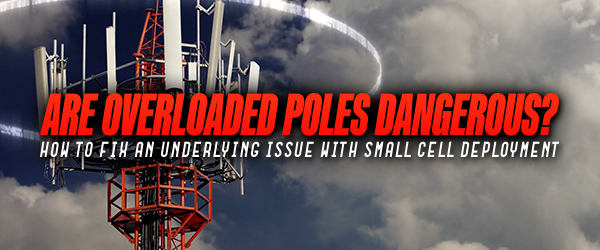
Are Overloaded Poles Dangerous? How to Fix an Underlying Issue with Small Cell Deployment
Utility poles, including light poles and electrical poles, are often used for more than their intended design. When carriers first introduced the idea of small cell wireless transmitters, one of the first ideas was to add them to utility poles. After all, these poles are spread across cities at regular intervals, making them appear to be ideal hosts for small cell attachments. However, installers soon discovered that a major drawback to this plan was the discovery that poles were already overloaded.
Disturbing Facts Regarding Overloaded Poles
A study done in Southern California revealed that out of the 1.4 million poles in the area, about 22 percent of them were technically overloaded. These poles did not meet the safety requirements for the area due to pulling too much power. This study was done at the recommendation of the California Public Utilities Commission after a number of overloaded poles actually sent sparks flying from their power boxes and caused power outages.
Out of 5,006 poles that the study looked at, 1,116 did not meet state regulations for electrical load. The state of California has three key requirements that all utility poles must meet, and while some poles only failed one of these regulations, some failed two or even all three. Thirteen poles that did not meet regulations were located in areas which were designed as being at high risk for fire.
Are Overloaded Poles Dangerous?
The incidents that prompted the CPUC study weren’t limited to a certain area or to specific types of incidents. Instead, overloaded poles led to dangerous situations in a number of locations and in several different ways.
In 2007, three utility poles in Los Angeles were blown over by the wind, leading to a major fire. By the time it was under control, over 3,800 acres had burned and 14 buildings had been destroyed. The poles were later determined to have been overloaded and in violation of regulations. While no fires were caused in 2011 when almost 250 utility poles were blown down in a windstorm, this did result in a loss of power for over 440,000 customers in the San Gabriel Valley. Many of these homes and businesses were without electricity for a week, and an examination of the poles revealed that 20 or more of them had been overloaded.
While the amount of power pulled by devices is a issue with respect to fire, the weight of overloaded poles has also caused concern. Pole arms that have additional equipment attached to them have been known to break off without any obvious reason. These incidents have often led to damage to vehicles and road closures.
Utility Poles and Small Cells
Placing small cells on utility poles requires wiring the devices into the electrical grid. If a utility pole is already near capacity, adding these devices can push it over the maximum load amount, creating the risk of sparks or fire. This is especially true if the utility pole is already being used for additional devices or applications. While the amount of power a small cell device draws isn’t as significant as what is needed for some equipment, it’s still an additional load that the utility pole must draw from the power grid.
This issue is yet another reason why utility poles aren’t the best solution for small cell deployment. On the surface, they appear to be, but the danger of overloading and causing a fire is a significant concern. The additional costs involved in permitting and installation, plus the fact that utility poles offer little protection from the environment, make utility poles less desirable for small cell deployment than they originally had appeared to be.
Solutions
Handling overloaded utility poles comes down to more carefully monitoring their loads and decreasing the amount of devices attached to them. This includes small cells. As agencies such as the California Public Utilities Commission focus more and more on the dangers of overloaded poles, it’s likely that the regulations for attaching devices to these poles will become increasingly strict. In some areas, utility poles may no longer even be an option for small cells.
That’s where SYNDÉO’s Smart Vault comes into play. This unique solution avoids many of the issues associated with overloaded utility poles. The Smart Vault is installed in a sidewalk or terrace, putting it completely underground. It’s connected to the power grid, but by being embedded in the sidewalk, the risk of fire is much less. Even if a fire were to start in a Smart Vault, it’s completely self-contained. The flames couldn’t spread anywhere or put anyone in danger.
The Smart Vault also resolves a number of other issues associated with utility poles. The smart cells are protected from the elements since the Smart Vault is waterproof. There’s no risk of the devices being damaged by high winds, hail, or other debris, either. Theft and vandalism also aren’t problems.
With the dangers of overloaded poles becoming more and more apparent, new solutions to the problems raised by adding equipment to utility poles must be considered. The Smart Vault is an excellent option for small cells.

